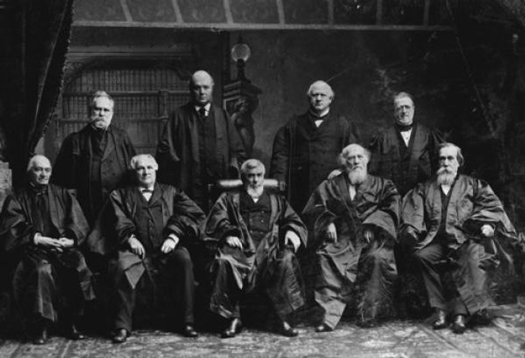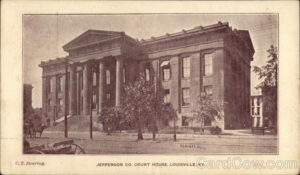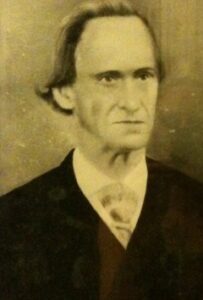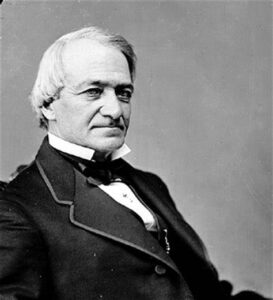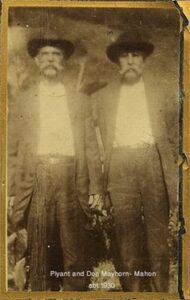
We are now beginning Part Five of the Hatfield and McCoy Feud. Just to make sure we understand where we are on the timeline of the Hatfield and McCoy Feud so far. New Year’s Night 1888, the cabin of Randolph McCoy was shot up and burned down.
We have one confirmed death of two children, Calvin, and Allaphare McCoy. We have Sheriff Frank Philipps crossing the West Virginia border from Kentucky to arrest 9 men for the murders and several others for resisting arrest. And now this is all heading to the Supreme Court of the United States of America.
There was a question as to the legality of this action. The Governors of the states of Kentucky and West Virginia have now sent troops to their borders from stopping other raids and trying to calm tensions.
The Tug River Valley is in an uproar. Nine men are sitting awaiting trial when Pliant Mahon files his suit against the state of Kentucky that will land on the desk of the Supreme Court. This lawsuit will affect how bounty hunters will operate the hunting of criminals when they cross over to other states for many years to come.
The District Court of the United States February 9, 1888
On February 9, 1888, the Governor of West Virginia presented to the District Court of the United States stating that on September 1887, the Governor of the state of Kentucky requested the arrest of Plyant Mahon for the alleged charge of murder and that he had fled to and was still at large in the State of West Virginia to avoid justice.
He further petitioned that during the month of December 1887, or January 1999 the said Plyant Mahon, while a resident and residing in the state of West Virginia, was in violation of her laws, the Constitution, and the laws of the United States. Also that Mahon was arrested without a warrant, or legal process by a body of armed men from Kentucky and by force and against his will was taken out of the state.
At the same time as these events, another petition was presented to the court by one John A. Sheppard, stating that his case was also like that of Plyant Mahon’s and that the governor’s facts were true. Subsequently, the name of Plyant Mahon was substituted for that of John A. Sheppard, and the proceedings on the petition were conducted in his name.
The Court then placed an order for the jailer, Abner Justice, of Pike County, Kentucky to bring the person of Plyant Mahon to the District Court fo the United States in Louisville, Kentucky on the 20th of that month, and there to abide until a decision was made in the case.
Pike County Jailer, Abner Justice’s Testimony
The Pike County Jailer’s response was that Mahon was being held in the Pike County jail under the obedience of three arrest warrants issued by the clerk of the criminal court of the county. Under these warrants, Mahon was being held for the crime of willful murder that had been alleged to have been committed in that county, a crime for which the court had full jurisdiction.
The jailer was proceeding to the City of Louisville to produce the body of Mahon before the United States district court where he was met on his way by the United States Marshal of the district of Kentucky. The United States Marshal had taken custody of Mahon by the order of the District of Kentucky.
Justice Testifies as to the Arrests
Abner Justice further replied that the three indictments against Mahon and others for the willful murder were found by the Grand Jury of Pike County, Kentucky, stating that the Grand Jury had jurisdiction over the case at that time. Believing these statements by the Grand Jury to be authentic and true, it was certified by the Governor of Kentucky and the said Govenor appointed Frank Philipps as the agent of the state to receive and bring to the state Mr. Mahon as provided by law in such cases. On or about January 12, 1888, Frank Phillips and others, with force and arms, did violently seize upon and capture Mahon and did bring him against his will to face charges in the state of Kentucky.
No Arrest Warrant Was Delivered
In his statement, Justice went on to further reply that no arrest warrant was issued against Mahon by the Governor of the State of West Virginia in compliance with the said requisition. That on January 30, 1888, replied to the Governor of state of Kentucky that after an investigation of the facts, and being fully satisfied in the case, that he could not find guilt in Mahon for the crime in which he was being charged.
Then on February 1, 1888, the Governor of the state of West Virginia demanded from the Governor of the state of Kentucky the release of Mahon from the Pike County jail and his safe return to the state of West Virginia. The Governor of the state of Kentucky denied this request stating that it was not the purview of his powers and duties as an acting Governor to determine the matter, but a case for the Courts and further held Mahon in custody pending trial.
On March 3, 1888, the court denied the motion for the release of Mahon, and the Marshal was then ordered to return Mahon to the custody of the Jailer, Abner Justice awaiting further court actions.
The Supreme Court
The Supreme Court became involved in the feud in 1888. The case is listed under Mahon v. Justice, 127 U.S. 700 (1888).
The State of West Virginia argued that Plyant Mahon should be released from confinement, set free, and returned in safety to the State of West Virginia as Mahon had been illegally arrested, seized, and confined in a common jail of Pike County, and deprived of his liberty by the state of Kentucky.
The Arguments
The state of Kentucky argued that the prisoner in custody, should remain so until trial and that was under no obligation to release them to the state of West Virginia or any other entity, regardless as to how they were arrested and retained.
Mahon’s attorneys argued that the Governor of the State of West Virginia was considering an application from the Governor of the State of Kentucky as a fugitive from justice when he was forcibly abducted by Philipps. Mayhon’s attorneys also made the argument that he was then seized by the Kentucky state authorities under legal process and was not entitled to be discharged from custody under a writ of habeas corpus from the circuit court of the United States.
Supreme Court Ruling
The Supreme Court of the United States of America ruled 7-2 in favor of Kentucky. The Supreme Court issued no finding or opinion on the question of the legality of the arrest of the group of men. However, they did agree with the state of Kentucky that at that time, no law existed which prohibited the trial of the men for murder to continue. The trial could carry on regardless of how they were arrested and brought into the state.
The Rulings of the Dissenting Judges
The two dissenting Judges, Mr. Justice Harlan, and Mr. Justice Bradley. Both agreed that the writ of habeas corpus was properly issued and the prisoner, Mahon, should have been discharged and released from custody. That he was being held against his will and this was contrary to the Constitution and the Laws of the United States.
Both judges felt that he was kidnapped and was carried into the state of Kentucky by force which was a plain violation of the Constitution of the United States and for him to continue to remain in the state of Kentucky was a violation of his Constitutional rights.
While it was true that Mahon was charged with a crime in the state of Kentucky, the Constitution provides for a peaceful remedy for procuring the surrender of persons charged with a crime and fleeing to another state. Such laws and treaties were put into place between the states for just such events.
It was felt that states could take justice into their own hands and demand each other reparations for the illegal invasions of their states if this ruling was allowed to stand. That also that the parties who are injured legally or otherwise could resort to reprisals or other measures that they might deem necessary in order to obtain justice.
Not All Who Were Accused Were Arrested
It is interesting that Anse Hatfield was not among those that were arrested and tried. Neither Kentucky nor West Virginia sought for his arrest in any of the events that took place even though his location was well known and a bounty of $500 was placed upon his person at one point during the feud. Anse Hatfield was never charged with the murders of the three McCoy Brothers or for the shooting of two young McCoy children or the beatings, kidnappings, or other things that were done.
Even though he was also known to use the courts to his advantage when it came to matters between the two clans of the feud, when the main trial was over, Hatfield was not on the “run” after that point in history. Many have pointed out that it may have been Hatfield’s political connections that kept him from being arrested, however, his brother, Wall, had similar connections and was thus arrested, tried, convicted, and sent to prison.
Source Material
All the Dirty Details About the Hatfield-McCoy Feud of the Late Nineteenth Century
https://historycollection.com/all-the-dirty-details-about-the-hatfield-mccoy-feud-of-the-late-nineteenth-century/
Hatfield–McCoy feud
https://en.wikipedia.org/wiki/Hatfield%E2%80%93McCoy_feud
The Untold Truth Of The Hatfield-McCoy Feud
https://www.grunge.com/349890/the-untold-truth-of-the-hatfield-mccoy-feud/
The Bloody Feud of the Hatfields and McCoys
https://www.legendsofamerica.com/hatfields-mccoys/
What’s the Real Story Behind the Hatfield-McCoy Feud?
https://www.wideopencountry.com/hatfields-and-mccoys-feud-real-story/
5 Things Hatfields and McCoys Still Feud Over
https://tourpikecounty.com/5-things-hatfields-and-mccoys-still-feud-over/
Mahon v. Justice, 127 U.S. 700 (1888)
https://supreme.justia.com/cases/federal/us/127/700/
Copyright and Other Information
Copyrighted through a Creative Commons License.
This work is licensed under a Creative Commons
Social Media Pages
Facebook
https://facebook.com/kytnliving
Twitter
https://twitter.com/KYTNLiving
YouTube
https://youtube.com/kytnliving
When we forget our past and who we are as a people, then we become who “they” say we are. ~~ David Sergent
I have attended the University of Kentucky. I have an Associates Degree from Hazard Community College and Technical School. I have also attended the University of Pikeville. I have taken several classes in Journalism as well as in the Appalachian History, Literature, and Sociology during my time at those schools.
I was born in Florida and grew up in Burdine, Kentucky. I have been married to David W. Sergent since May 4, 2013. I have two children and four grandchildren from a previous marriage. I currently live in Tennessee but my hope is to one day come back home to live in the beautiful mountains once more.


